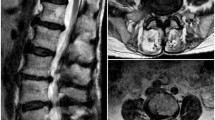Abstract
Due to the anatomical situation, intervertebral disc herniation usually results in compression of the anterior epidural space, with lateral or medial irritation of nerve root or cauda equina. Rare locations are an intra- or extraforaminal position or dislocation dorsally. Three patients with dorsal cauda equina compression caused by a sequestered herniated nucleus pulposus (HNP) are reported. The patients complained mainly of severe back pain. In two patients nondermatome-related leg pain was observed; one patient suffered additionally from incomplete cauda equina syndrome. In all cases magnetic resonance imaging and computed tomography diagnosed neoplastic tissue.
Similar content being viewed by others
Author information
Authors and Affiliations
Additional information
Received: 26 July 2000
Rights and permissions
About this article
Cite this article
Eysel, P., Herbsthofer, B. Dorsal compression of the epidural cord due to free sequestral lumbar prolapse . Arch Orth Traum Surg 121, 238–240 (2001). https://doi.org/10.1007/s004020000213
Issue Date:
DOI: https://doi.org/10.1007/s004020000213




